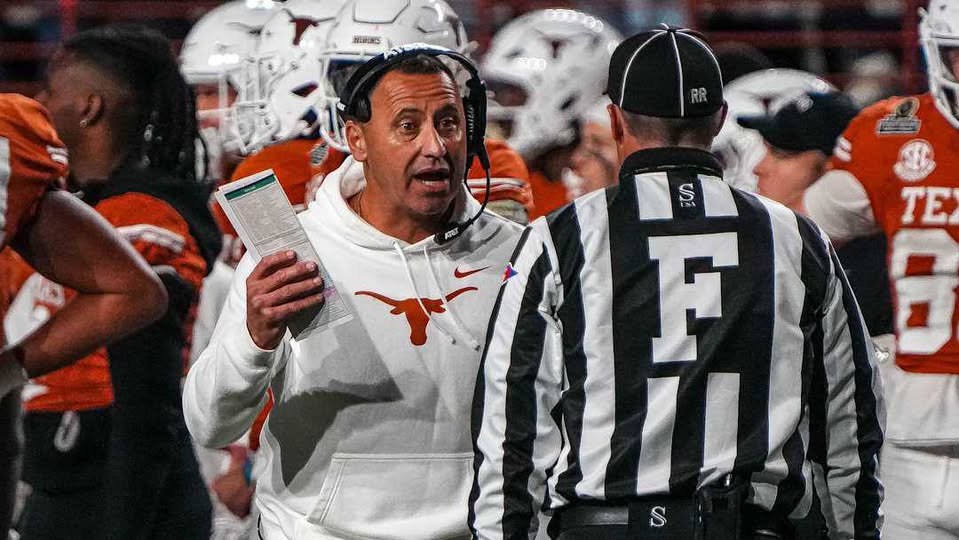The battle lines in college football recruiting are always drawn deep, but when it comes to the state of Texas, the conflict transforms into something personal, emotional, and deeply strategic. That reality came crashing down on the University of Texas this week as they suffered a painful recruiting defeat in one of the most high-profile head-to-head matchups in the 2026 class. Four-star running back KJ Edwards, a blue-chip prospect from Carthage, Texas, stunned the Longhorn faithful by committing to Texas A&M, bypassing what many assumed was a near-certain future in Austin.
For head coach Steve Sarkisian and his staff, this isn’t just a lost recruit. It’s a seismic tremor that could reshape the perception of the Longhorns’ recruiting dominance—particularly now that the Longhorns are full-fledged members of the Southeastern Conference (SEC), where roster strength translates directly into national title viability.
Let’s break down the depth of this recruiting loss, what it says about both programs, and where Texas goes from here.
WHO IS KJ EDWARDS?
KJ Edwards is not just another four-star athlete. He’s widely considered one of the most complete backs in the nation, ranking among the top 50 players nationally, the No. 2 running back in the country, and the No. 5 player in the state of Texas. At 6-foot, 195 pounds, Edwards possesses an elite blend of vision, balance, and breakaway speed, complemented by his effectiveness as a pass catcher out of the backfield.
During his junior season at Carthage High School, Edwards rushed for 1,789 yards and 23 touchdowns, while adding 383 yards and 3 TDs receiving. His explosiveness made him a sought-after commodity, with offers from powerhouses such as Alabama, LSU, Oregon, and, of course, Texas.
For months, the Longhorns were perceived to be the front-runner. Edwards had long-standing relationships with Texas position coaches and had visited the campus more than once. But as the summer heated up, Texas A&M quietly built momentum, and by the time Edwards canceled his official visit to Austin, the writing was on the wall.
WHY THIS RECRUITMENT LOSS HITS HARD
Texas losing a major recruit is rare, especially one within state lines. But losing that recruit to Texas A&M—their fiercest recruiting rival—is particularly damaging. Not only do the Longhorns lose an elite player, but they strengthen a direct competitor in the SEC West, a division where one playmaker can tilt the scales.
Here’s why this loss cuts deep:
- Symbolism: The Longhorns have prided themselves on controlling the Lone Star State. Losing a top-five Texas player to the Aggies challenges that authority.
- SEC Rivalry: With both teams now playing under the SEC banner, future showdowns could see Edwards lining up against the very program he spurned.
- Recruiting Optics: When a top talent chooses a rival, it sends a message to other recruits—Texas is no longer the obvious destination for elite in-state athletes.
THE NIL FACTOR
Though KJ Edwards has publicly stated that his decision was not based on NIL (Name, Image, and Likeness) deals, industry insiders suggest otherwise. The Aggies have, in recent years, established one of the most aggressive NIL collectives in the country, often outpacing programs with even deeper football legacies.
Texas has its own formidable NIL infrastructure through the Clark Field Collective, but whispers around this recruitment suggest that A&M’s deal was structured with greater flexibility and longer-term visibility.
More concerning for the Longhorns is the pattern: they’ve missed on several top-tier recruits this cycle—some directly because of NIL considerations. While Texas aims to be selective and strategic, recruits are clearly being swayed by more aggressive offers.
STRATEGIC MISSTEPS?
Texas had momentum heading into the summer. They had landed key commitments on both offense and defense and were expected to close strong in June and July. But the loss of assistant coaches—most notably running backs coach Tashard Choice to the NFL’s Detroit Lions—created instability just as major decisions were being made.
Recruiting is relationship-based. Edwards had a close bond with Choice, and while the Longhorns scrambled to re-establish rapport with a new staffer, A&M doubled down with consistent messaging and personal attention.
Additionally, there are indications that Texas may have underestimated the strength of A&M’s pitch, especially as it pertained to development and early playing time. With A&M’s running back room lacking a true bell cow, Edwards was promised a chance to start from Day One.
PATTERN OF LOSSES
The defeat in the Edwards sweepstakes is part of a larger, troubling trend. In the past two weeks alone, Texas has missed on the following high-profile recruits:
- Aaron Gregory, a top-50 wide receiver, reaffirmed his commitment to A&M despite being courted heavily by Texas and Oregon.
- Samuel Roseborough, a four-star offensive lineman, shocked insiders by choosing the Aggies over the Longhorns following a visit to Austin that reportedly “lacked energy.”
- Tristan Blue, a five-star safety out of Florida, removed Texas from his top 3 after a seemingly positive official visit.
These aren’t isolated incidents—they’re signals that Texas’s recruiting approach is in need of recalibration.
✅ WHERE TEXAS STANDS NOW
Despite these setbacks, the Longhorns still have a top-10 recruiting class and elite talent on the roster. Five-star quarterback Julian Lewis remains locked in. Wide receivers Kohen Brown and Mykel Trigg continue to impress in camp, and the defensive side has commitments from key pieces like linebacker Derrick “DJ” Harmon and safety Javion Murray.
In the transfer portal, Texas has also done well, securing plug-and-play starters at corner, linebacker, and tight end. But building through the portal isn’t sustainable long-term, especially for foundational positions like running back and offensive line.
CAN TEXAS FLIP EDWARDS?
It’s rare, but not impossible. Texas has pulled off late flips before—most notably with wide receiver Ryan Wingo last cycle. The key would be:
- Reestablishing a personal relationship.
- Demonstrating a clear path to early playing time.
- Sweetening the NIL situation to match or exceed what A&M offered.
But make no mistake—this would take a miracle. For now, Texas is better off refocusing its energy on landing other elite backs still uncommitted, including five-star Devon Marcus (California) and four-star Jevon Williams (Louisiana).
WHAT THIS MEANS LONG TERM
If Texas fails to correct its course, more top-tier Texas prospects may drift to A&M, Oklahoma, Oregon, and Alabama. And once a pipeline closes, reopening it is hard—especially with public confidence shaken.
However, if Texas finishes the 2026 cycle strong and has a successful SEC debut season, all of this may be forgotten. A winning season, a bowl appearance, and a Heisman contender under center can do wonders.
But to stay relevant in the SEC, you can’t just win on Saturdays. You have to win on Signing Day too.
FAN REACTION AND MEDIA SPIN
The Longhorn fan base has been vocal about the Edwards decision. Social media forums, message boards, and podcasts have exploded with reactions ranging from disbelief to frustration. Some blame NIL strategy, others coaching turnover, and some even the administration for being too cautious.
Local and national media outlets have also weighed in:
- The Austin American-Statesman called it “a wake-up call.”
- 247Sports rated the loss as one of the “Top 5 most impactful recruiting misses of the summer.”
- ESPN’s Paul Finebaum said Texas “needs to take this personally—and respond with fire.”
The message is clear: Texas can’t afford to lose more battles like this, especially not to Texas A&M.
CLOSING THOUGHTS
The world of college football recruiting is high-stakes and unforgiving. A single decision by a teenager can alter the trajectory of a program. For Texas, the loss of KJ Edwards is more than a missed opportunity—it’s a challenge to their identity as the dominant power in the Lone Star State.
Whether this marks a short-term stumble or a longer-term slide depends entirely on how Steve Sarkisian and his staff respond. The ball is in their court.



